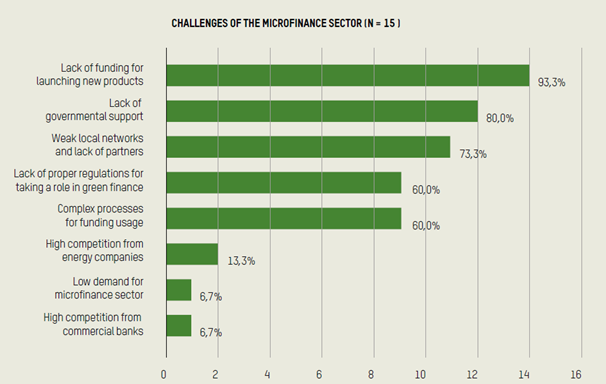Green Inclusive Finance in Sub-Saharan Africa: Enabling environments, challenges, and opportunities
Sub Saharan Africa is highly vulnerable to climate change, which is worsened by issues like extreme poverty, lack of basic services, reliance on biomass for cooking, insufficient clean water and sanitation, and gender inequalities. Financial Service Providers (FSPs) and their clients in SSA are already feeling the effects of climate change, and green inclusive finance practices are needed to mitigate these risks. Green inclusive finance supports economic opportunities and responds to the needs of households and micro, small, and medium-sized enterprises (MSMEs) that are (partially) excluded by the standard banking sector, with the primary purpose of increasing resilience to climate change, mitigating adverse environmental impact, and fostering sustainability.
Study Overview
HEDERA conducted a study for the Oxfam Novib Fund to explore green inclusive finance in Sub-Saharan Africa (SSA). The study had three main parts:
- Desk Research: Covering 17 SSA countries, it provided an overview of climate risks, stressors, and impacts, as well as initiatives and programs helping FSPs raise awareness and implement green finance activities.
- Interviews: Conducted with 12 stakeholders, including sector associations, impact investors, microfinance networks, think tanks, and standards developers, to analyze experiences, challenges, and lessons learned in offering green products.
- Survey: Involving 15 FSPs from the Oxfam Novib Fund portfolio in 9 SSA countries to assess the development of green inclusive finance.
Case study: integrating green inclusive finance at ACEP Burkina FasoEstablished in 2012, ACEP Burkina Faso is part of the ACEP International network and serves over 47,000 MSMEs. The organization developed an environmental strategy to address clients’ environmental expectations, mitigating climate-related financial risks and to capitalize on green economy opportunities. It has a committee that oversees environmental and social issues, reporting to the board and investors every two years. ACEP also conducts awareness campaigns on environmental protection, finances green products like renewable energy and waste management solutions, and offers non-financial services for environmental emergencies. These initiatives are integrated into its lending practices and risk management. |
Key Findings
In the last decade, green finance regulations and policies have emerged in SSA countries like Kenya and Nigeria. However, these are mostly aimed at commercial banks, and not at not microfinance institutions. Despite the fact that various stakeholders have shown increased commitment to advancing green inclusive finance in the region, the enabling environment is yet to advance. Some institutions, with stakeholder support, have developed green products, trained staff and clients, and identified technologies to help clients adapt to climate change. However, the focus has mainly been on climate mitigation, and there is also a need to address climate adaptation, resilience, and transition, especially in a region where climate risks are strongly linked with other vulnerabilities and should be addressed holistically.

|
The 15 interviewed African FSPs from the Oxfam Novib Fund perceived a high demand for green finance in the microfinance sector, low competition from energy companies financing last-mile and low competition from peer commercial banks delivering green products. On the other hand, the lack of funding for launching new products (93.3%), the lack of governmental support (80%), the weakness of local networks, and the lack of partners (73.3%) were the most mentioned challenges for an enabling environment for green inclusive finance in the respective countries. 60% of the respondents indicated that the lack of proper regulations for taking a role in green finance and the complexity of processes related to funding usage were significant factors. |
To scale up green products in SSA, it's important for FSPs to develop local climate risk maps and have an integrated climate strategy. Sector frameworks and taxonomies can help to identify gaps, create action plans, and monitor progress and innovation. Networks of microfinance institutions in the region could play a key role in achieving climate strategies and risk management, sharing efficiencies, lessons learned, and best practices. Investors in FSPs could help with capacity building, stakeholder coordination and fine-tuned funding to launch green products.
Full report
Green Inclusive Finance in Sub-Saharan Africa – Enabling environments, challenges, and opportunities. Technical Report, Oxfam Novib & Triple Jump, prepared by N. Realpe & HEDERA Sustainable Solutions (2024)




